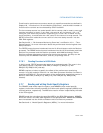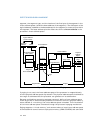
Vol. 3 3-7
PROTECTED-MODE MEMORY MANAGEMENT
In 64-bit mode, segmentation is generally (but not completely) disabled, creating a
flat 64-bit linear-address space. The processor treats the segment base of CS, DS,
ES, SS as zero, creating a linear address that is equal to the effective address. The FS
and GS segments are exceptions. These segment registers (which hold the segment
base) can be used as an additional base registers in linear address calculations. They
facilitate addressing local data and certain operating system data structures.
Note that the processor does not perform segment limit checks at runtime in 64-bit
mode.
3.2.5 Paging and Segmentation
Paging can be used with any of the segmentation models described in Figures 3-2,
3-3, and 3-4. The processor’s paging mechanism divides the linear address space
(into which segments are mapped) into pages (as shown in Figure 3-1). These linear-
address-space pages are then mapped to pages in the physical address space. The
paging mechanism offers several page-level protection facilities that can be used
with or instead of the segment-protection facilities. For example, it lets read-write
protection be enforced on a page-by-page basis. The paging mechanism also
provides two-level user-supervisor protection that can also be specified on a page-
by-page basis.
3.3 PHYSICAL ADDRESS SPACE
In protected mode, the IA-32 architecture provides a normal physical address space
of 4 GBytes (2
32
bytes). This is the address space that the processor can address on
its address bus. This address space is flat (unsegmented), with addresses ranging
continuously from 0 to FFFFFFFFH. This physical address space can be mapped to
read-write memory, read-only memory, and memory mapped I/O. The memory
mapping facilities described in this chapter can be used to divide this physical
memory up into segments and/or pages.
Starting with the Pentium Pro processor, the IA-32 architecture also supports an
extension of the physical address space to 2
36
bytes (64 GBytes); with a maximum
physical address of FFFFFFFFFH. This extension is invoked in either of two ways:
• Using the physical address extension (PAE) flag, located in bit 5 of control
register CR4.
• Using the 36-bit page size extension (PSE-36) feature (introduced in the Pentium
III processors).
Physical address support has since been extended beyond 36 bits. See Chapter 4,
“Paging” for more information about 36-bit physical addressing.


















